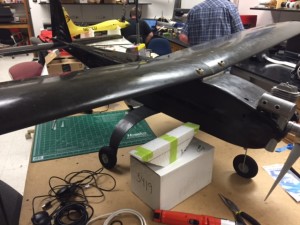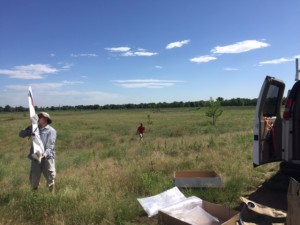This week the team prepared to test our new systems in preparation for RECUV’s upcoming deployments. First on the list was getting the simulations that we had written the code for last week running. They went very well, proving that our autopilot is capable of following a moving vehicle. Early in the week, I also put together an old Ares UAV that had been sitting in pieces in one of our labs. It was an important aircraft for RECUV, as it was the first they had designed and manufactured themselves. Because of this, they wanted to display it somewhere, so I was given the task of reassembling it for display.
On Wednesday I also got the chance to work with the “other side” of RECUV: the team that does work with rovers and ground robots rather than aircraft. Currently, they are researching the possibility of using humans as a sort of sensor for robots. They built a floor plan out of plywood and a few tables, and have four small rovers that can move around in the simulated house. The robots play a kind of cops and robbers game where humans can help the cop by looking for the robbers and telling the cop where to look with normal language rather than commands. The team is trying to find a way to make the robots recognize human speech in a way that allows them to use it for information rather than just carrying out a task as most voice recognition software currently does. I was able to help out by creating some 3D models for their simulations using xml files.
Returning to the aircraft side of things for the rest of the week, I helped assemble our new antenna box that uses a wifi link rather than the previous high-gain radio tracking antenna. The wifi link has similar range while being faster and much less complicated to use than our old setup. Unfortunately, although the hardware was assembled, we were not able to get the link working by Friday, which is when we had intended to test it. We were still able to fly on though, but tested a different system than originally intended: a camera system that takes many photos of an area from the UAV and pieces them together into one very high resolution image of a large area. These tests went well, and we were able to get the wifi link working in the lab after the flights.
Next week will be spent testing the new antenna as well as creating an aerodynamic prototype of RECUV’s newest aircraft. Hopefully this will entail a few more flights, those are always the most fun! I also get to learn to use the CNC foam cutting machine to build this new aircraft. Should be fun, as everything else has been! Looking forward to the last two weeks!



There are no comments published yet.